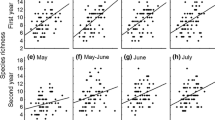Abstract
The utility of biomass density (biomass per unit volume) as a quantitative descriptor of the growth form of submerged macrophytes is evaluated and confirmed. Biomass density (BD) is a species specific characteristic which does not appear to be influenced by plant development. Secondly, BD reflects the growth form of the dominant species in the stand, because stands of species with a similar growth form also have similar BD's. Lastly, the BD of submerged macrophyte stands is closely related to the flowering pattern of the dominant species, and has important implications for light capture and light competition with neighbouring plants. Thus, BD should be a useful tool in the quantitative analysis of submerged macrophyte community structure.
Similar content being viewed by others
References
Ackerman, J. D., 1986. Mechanistic implications for pollination in the marine angiosperm Zostera marina. Aquat. Bot. 24: 343–353.
Anderson, M. G., 1978. Distribution and production of sago pondweed (Potamogeton pectinatus L.) on a Northern prairie marsh. Ecology 59: 154–160.
Andrews, M., I. R. Davidson, M. E. Andrews & J. A. Raven, 1984. Growth of Chara hispida. 1. Apical growth and basal decay. J. Ecol. 72: 873–88.
Chambers, P. A. & J. Kalff, 1987. Light and nutrients in the control of aquatic plant community structure. I. In situ experiments. J. Ecol. 75: 611–619.
Cook, C. D. K. & K. Urmi-König, 1985. A revision of the genus Elodea (Hydrocharitaceae). Aquat. Bot. 21: 111–156.
Cox, P. A., 1983. Search theory, random motion, and the convergent evolution of pollen and spore morphology in aquatic plants. Am. Nat. 121: 9–31.
Downing, J. A. & M. R. Anderson, 1985. Estimating the standing biomass of aquatic macrophytes. Can. J. Fish. aquat. Sci. 42: 1860–1869.
Duarte, C. M. & J. Kalff, 1987. Weight-density relationships of submerged macrophytes: the importance of light and growth form. Oecologia (Berlin) 72: 612–617.
Engel, S., 1985. Aquatic plant community interactions of submerged macrophytes. Tech. Bull. 156. Wisconsin Department Natural Resources. Madison. 79 pp.
Fassett, N. C., 1966. A Manual of Aquatic Plants. University of Wisconsin Press, Madison, 405 pp.
Geiger, N. S., 1983. Winter drawdown for the control of eurasian water milfoil in an Oregon oxbow lake (Blue Lake, Mitnomah County) P 193–197. In J. Taggart (ed.), Lake Restoration, Protection and Management, EPA, Washington, 327 p.
Getsinger, K. D. & C. R. Dillon, 1984. Quiescence, growth and senescence of Egeria densa in Lake Marion. Aquat. Bot. 20: 329–338.
Grace, J. B. & L. J. Tilly, 1976. Distribution and abundance of submerged macrophytes, including Myriophyllum spicatum L. (Angiospermae), in a reactor cooling reservoir. Arch. Hydrobiol. 77: 475–487.
Goldyn, H., 1984. Biomass of macrophytes in the channel running through agricultural areas. Ekol. pol. 32: 167–176.
Harlan, S. M., G. C. Davis & G. J. Pesacreta, 1985. Hydrilla in three North Carolina lakes. J. Aquat. Plant Manage. 23: 68–71.
Hutchinson, G. E., 1975. A Treatise in Limnology. Vol. III. Limnological Botany. J. Wiley, New York, 660 pp.
Ikusima, I., 1966. Ecological studies on the productivity of aquatic plant communities II. Seasonal changes in standing crop and productivity of a natural submerged community of Vallisneria denseserrulata. Bot. Mag., Tokyo 79: 7–19.
Jupp, B. P. & D. H. N. Spence, 1977. Limitation of macrophytes in a eutrophic lake, Loch Leven. II Wave action, sediments and waterfowl grazing. J. Ecol. 65: 431–446.
Kirk, J. T. O., 1983. Light and photosynthesis in the aquatic environment. Cambridge Univ. Press. New York, 401 pp.
Kunii, H., 1984. Seasonal growth and profile structure development of Elodea nuttallii (Planch.) St. John in pond Ojaga-Ike, Japan. Aquat. Bot. 18: 239–247.
Lind, C. T. & G. Cottam, 1969. The submerged aquatics of University Bay: A study in eutrophication. Amer. Midl. Nat. 81: 353–369.
Lonsdale, W. M. & A. R. Watkinson, 1983. Plant geometry and self thinning. J. Ecol. 71: 285–297.
Luther, H., 1983. On life form and on above ground and underground biomass of aquatic macrophytes. Acta Bot. Fennica 123: 1–23.
Moeller, R. E., 1985. Macrophytes. p. 177–192. In G. E. Likens (ed.), An Ecosystem Approach to Aquatic Ecology. Mirror lake and its environment. Springer-Verlag, New York, 516 pp.
Ozimek, T., 1978. Effect of municipal sewage on the submerged macrophytes of a lake littoral. Ekol. Pol. 26: 3–39.
Owens, M., M. A. Learner & P. J. Maris, 1967. Determination of the biomass of aquatic plants using an optical method. J. Ecol. 54: 671–676.
Pereira-Ramos, E., 1982. The ecological role of Characeae in the lake littoral. Ekol. Pol. 29: 167–209.
Pokorný, J., Květ, J. P. Ondok, Z. Toul & I. Ostrý, 1984. Production-ecological analysis of a plant community dominated by Elodea canadensis. Michx. Aquat. Bot. 19: 263–292.
Rasmussen, J. B., 1988. Littoral zoobenthic biomass in lake, and its relationship to physical, chemical, and trophic factors. Can. J. Fish. aquat. Sci. 45: 1436–1447.
Rørslett, B., 1985. Death of submerged macrophytes — actual field observations and some implications. Aquat. Bot. 22: 7–19.
Rørslett, B., 1987. A generalized spatial niche model for aquatic macrophytes. Aquat. Bot. 29: 63–81.
Rørslett, B., D. Bergel & S. W. Hohansen, 1986. Lake enrichment by submersed macrophytes: a Norwegian whole-lake experience with Elodea canadensis. Aquat. Bot. 26: 325–340.
Sculthorpe, C. D., 1967. The Biology of Aquatic Vascular Plants. Edward Arnold, London, 610 pp.
Sokal, R. R. & F. J. Rohlf, 1969. Biometry: the principles and practice of statistics in biological research. W. H. Freeman, San Francisco, 776 p.
Verhoeven, J. T. A., 1980. The ecology of Ruppia-dominated communities in western Europe. III. Aspects of production, consumption and decomposition. Aquat. Bot. 8: 209–253.
White, J., 1981. The allometric interpretation of the self-thinning rule. J. theor. Biol. 89: 475–500.
White, J., 1985. The thinning rule and its application to mixtures of plant populations. P 291–309. In J. White (ed.), Studies on plant demography. Academic Press, London, 393 p.
Author information
Authors and Affiliations
Additional information
#244 contribution to the Lake Memphremagog Project, McGill Limnology Center.
#244 contribution to the Lake Memphremagog Project, McGill Limnology Center.
Rights and permissions
About this article
Cite this article
Duarte, C.M., Kalff, J. Biomass density and the relationship between submerged macrophyte biomass and plant growth form. Hydrobiologia 196, 17–23 (1990). https://doi.org/10.1007/BF00008889
Received:
Revised:
Accepted:
Issue Date:
DOI: https://doi.org/10.1007/BF00008889




